|
Company F, Sixty-first Regiment North Carolina Troops
Alfred May,
Company F, Sixty-first Regiment North Carolina Troops
Alfred May
I have no news of importance to tell you. We have been on a tramp
to Suffolk. We stayed there five nights and returned to our same place, Proctor's Ferry. —Sergeant Alfred
May, Company F (Trio Guards), Sixty-first Regiment North Carolina Troops, March 4, 1864
| U.S. Senator Thomas Clingman |
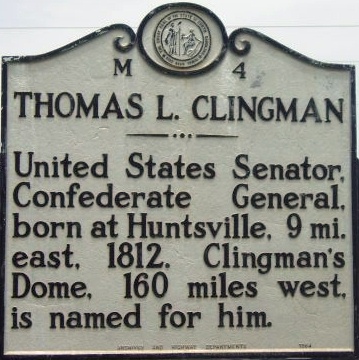
|
| (Historical Marker) |
Alfred May left his Pitt County home in the summer of 1862 and traveled
to Wilmington, where on August 25 he enlisted in Company F (Trio Guards), Sixty-first Regiment North Carolina Troops. He served
in the same unit as his older brothers Robert and Benjamin May.
The 61st North Carolina, attached to the famous Clingman Brigade, which was composed entirely of North Carolina troops, fought in eastern North Carolina in 1862, and in 1863
it engaged in fierce combat at Battery Wagner (Fort Wagner), near Charleston, and it inflicted heavy losses
on the renowned 54th Massachusetts (Colored) Infantry.
On July 18, 1863, along with two
brigades of white troops, the 54th assaulted Confederate Battery Wagner. Colonel Robert Gould Shaw led his men into battle
by shouting: "Forward, Fifty-fourth, forward!" He mounted a parapet and urged his men forward, but was shot through the heart
and he died almost instantly; his body fell into the fort.
"While in the Charleston area, July 10 to September 6, 1863, the 61st North Carolina
lost 6 killed, 35 wounded and 76 missing."
The following year, the Sixty-first North Carolina fought in several battles
around Richmond. Benjamin suffered a wound to the head at Petersburg in July 1864, and Robert died in a Richmond hospital of unrecorded causes in October. The regiment participated in the last
major battle of the war at Bentonville in March 1865.
| Storming of Fort Wagner by Union Troops |
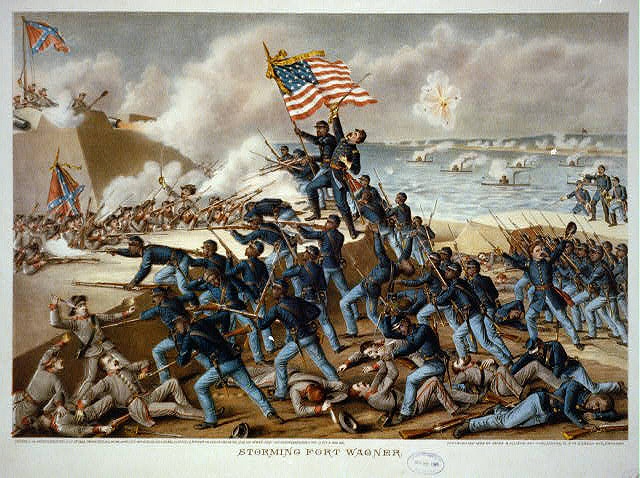
|
| (LOC) |
(The Storming of Fort Wagner by Union Troops--lithograph by Kurz and Allison, 1890.)
Canteen of Alfred May
| Confederate Canteen |
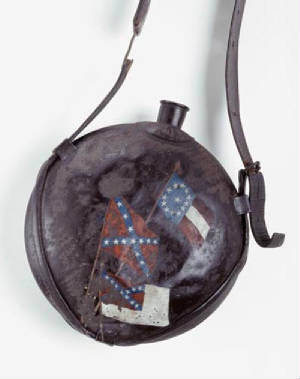
|
| (Click to Enlarge) |
| Civil War Canteen |
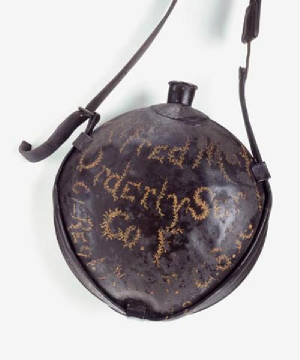
|
| (Click to Enlarge) |
At some point in the war's final days or after the Confederate surrender,
Alfred returned home and carefully put away his uniform, rifle, cartridge box, pistol, and many other items, including objects
that he apparently carried home as battlefield souvenirs. The grouping of artifacts displayed here is unique. It is the largest
extant collection of objects associated with a North Carolina Confederate enlisted soldier.
Alfred May carried this United States Army M1858 canteen during the Civil
War. May was born in Pitt County and enlisted in Company F, Sixty-first Regiment North Carolina Troops in August 1862. Company
F was known as the "Trio Guards" because it included soldiers from Pitt, Wilson, and Green counties. In addition to Alfred
his two brothers also served in the same unit. Alfred May survived the war and returned home without surrendering and put
all of his army accouterments away. His extensive collection was donated to the North Carolina Museum of History in 1996.
| North Carolina Civil War Battlefields Map |
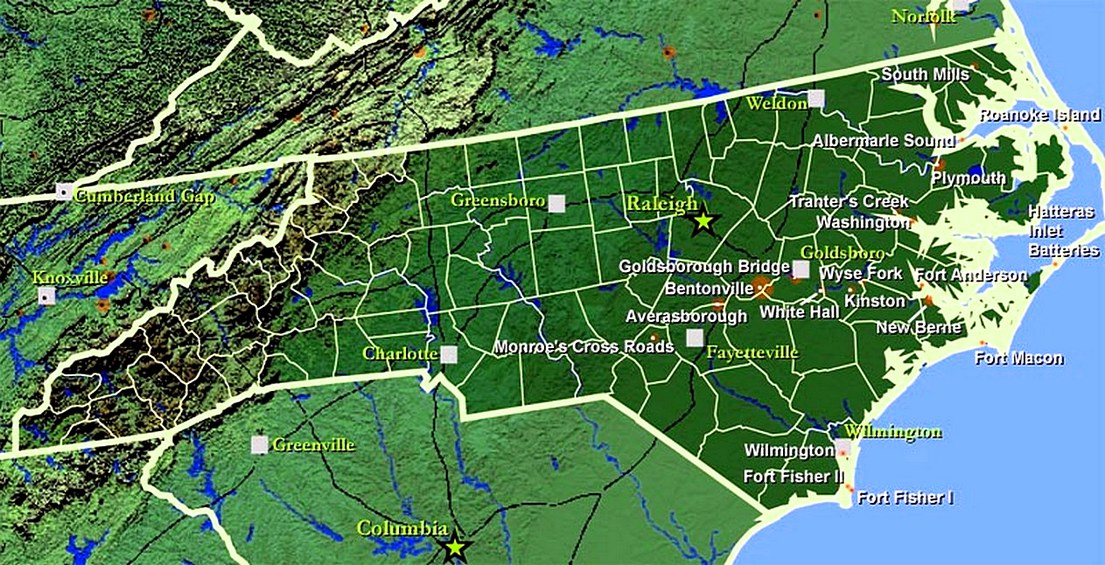
|
| High Resolution Map of North Carolina Civil War Battlefields |
Interesting facts
Thomas Clingman initially commanded the Twenty-fifth North Carolina
Infantry Regiment before being promoted to brigade commander. The real Private W. P. Inman, portrayed by Jude Law in the movie Cold Mountain, was a Haywood County highlander who had served in Company F, Twenty-fifth
North Carolina.
The Fifty-fourth Massachusetts (Colored) Infantry has
been honored with the Oscar winning movie, Glory , starring Denzel Washington, Morgan Freeman, Andre Braugher, and Matthew Broderick. The movie won three Oscars. , starring Denzel Washington, Morgan Freeman, Andre Braugher, and Matthew Broderick. The movie won three Oscars.
Sources: North Carolina Museum of History; Official Records of the Union
and Confederate Armies; Walter Clark, North Carolina Regiments, Volume III; Library of Congress; National Archives.
Recommended Reading: Clingman's
Brigade in the Confederacy. Description: Renowned
historian and author Frances H. Casstevens, Out of the Mouth of Hell: Civil War Prisons and Escapes and Tales from the North And the South, delivers another masterpiece in Clingman's Brigade. "...I felt as though I was part of that brigade;
I could graphically see the horror, the hell... the advance into shot and shell!" On November 11, 1862, Brigadier General
Thomas Lanier Clingman, despite a lack of formal military training, was named commander of four regiments sent to the eastern
counties of North Carolina to prevent Federal troops from making further inroads into the state. Continued
Below... Out of the Mouth of Hell: Civil War Prisons and Escapes and Tales from the North And the South, delivers another masterpiece in Clingman's Brigade. "...I felt as though I was part of that brigade;
I could graphically see the horror, the hell... the advance into shot and shell!" On November 11, 1862, Brigadier General
Thomas Lanier Clingman, despite a lack of formal military training, was named commander of four regiments sent to the eastern
counties of North Carolina to prevent Federal troops from making further inroads into the state. Continued
Below...
Clingman has been called one of North Carolina’s most colorful and
controversial statesmen, but his military career received little attention from his contemporaries and has been practically
ignored by later historians. Like
Clingman, the brigade, composed of the 8th, 31st, 51st, and 61st regiments of North Carolina Infantry, has been both praised
and condemned for its performance in battle. Clingman's Brigade is a treasured
addition to every Civil War buff's library.
Advance to:
NEW! HIGHLY Recommended Viewing! The American Civil War (DVD Megaset)
(2009) (A&E Television Networks-The History Channel) (14 DVDs) (1697 minutes) (28 Hours 17 Minutes
+ extras). Experience for yourself the historical and personal impact of the Civil War in a way that only HISTORY
can present in this moving megaset™, filled with over 28 hours of American Civil War content. This
MEGASET is the most comprehensive American Civil War compilation to date and is the mother of all Civil War documentaries.
A multifaceted look at “The War Between the States,” this definitive collection brings the most legendary Civil
War battles, and the soldiers and leaders who fought them, vividly to life. From Gettysburg and Antietam to Shiloh, and led
by the likes of Sherman, McClellan, Grant, Beauregard, Lee, Davis, and Jackson, delve into the full military and political
contexts of these men, their armies, and the clashes between them. Continued below...
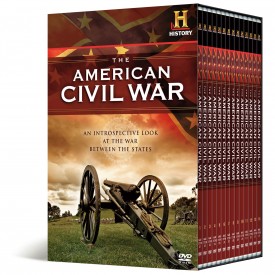
Almost 150 years after Lee’s surrender at Appomattox Court House,
the unexpected secrets and little-known stories from Civil War history are divulged with fascinating detail. Cutting-edge
CGI and accurate dramatizations illustrate archival letters and original diary entries, and the country’s most renowned
historians describe the less familiar incidents that add perspective and depth to the war that divided a nation. If the DVDs
in this Megaset were purchased separately, it could cost hundreds of dollars. This one-of-a-kind compilation belongs on the
shelf of every Civil War buff, and if you know anyone that is interested in the most costliest and bloodiest war in American
history, buy this, they will love it.
THE AMERICAN CIVIL WAR contains the following programs:
* The Most Daring Mission Of The Civil War
* April 1865
* Battlefield
Detectives: The Civil War (3 Episodes): Antietam, Gettysburg, Shiloh
* Secret Missions Of The Civil War
* The Lost Battle
Of The Civil War
* Tales Of The Gun: Guns Of The Civil War
* Eighty Acres Of Hell
* Lincoln
* Investigating History:
Lincoln: Man Or Myth
* Man, Moment, Machine: Lincoln & The Flying, Spying Machine
* Conspiracy?: Lincoln Assassination
*
High Tech Lincoln
* Sherman’s March
* The Hunt For John Wilkes Booth
* Civil War Combat (4 Episodes): The Hornets’
Nest At Shiloh, The Bloody Lane At Antietam, The Wheatfield At Gettysburg, The Tragedy At Cold Harbor
* Civil War Journal
(8 Episodes): John Brown's War, Destiny At Fort Sumter, The Battle of 1st Bull Run, The 54th Massachusetts, West Point Classmates—Civil
War Enemies, Robert E. Lee, Stonewall Jackson, Sherman And The March To The Sea
BONUS FEATURES:
* Full-Length Documentary “Save Our History: Sherman’s Total
War Tactics”
* Behind the Scenes Featurettes for “Sherman’s March” and “Lincoln”
Recommended Reading: Confederate Military
History Of North Carolina: North Carolina In The
Civil War, 1861-1865. Description: The author, Prof. D. H. Hill,
Jr., was the son of Lieutenant General Daniel Harvey Hill (North Carolina produced only two lieutenant generals and it was the second highest rank in the army)
and his mother was General “Stonewall” Jackson’s wife's sister. In Confederate Military History Of North Carolina, Hill discusses North Carolina’s
massive task of preparing and mobilizing for the conflict; the many regiments and battalions recruited from the Old North
State; as well as the state's numerous contributions during the war. Continued below...
During
Hill's Tar Heel State study, the reader begins with interesting and
thought-provoking statistical data regarding the 125,000 "Old North State" soldiers that fought during the course of the war and the 40,000 that perished.
Hill advances with the Tar Heels to the first battle at Bethel,
through numerous bloody campaigns and battles--including North
Carolina’s contributions at the "High Watermark" at Gettysburg--and concludes with Lee's surrender at Appomattox.
Recommended Reading: The Flags of Civil War North Carolina. Description: Compiled
and written by educator and Civil War expert Glenn Dedmondt, The Flags Of Civil War North Carolina is a very straightforward reference presenting
photographs, color illustrations, descriptions and history of the titular flags that flew over North Carolina when it seceded from the Union. Each page or two-page spread features the different flags of the various North Carolina regiments.
A meticulously detailed resource offering very specific information for history and civil war buffs, The Flags Of Civil War
North Carolina is a welcome contribution to the growing library of Civil War Studies and could well serve as a template for
similar volumes for the other Confederate as well as Union states. Great photos and illustrations! Continued below...
Flags stir powerful emotions,
and few objects evoke such a sense of duty and love for the homeland. In April 1861, the first flag of a new republic flew
over North
Carolina. The state had just seceded from the union, and its citizens would soon have to fight for
their homes, their families, and their way of life. Each flag ismeticulously detailed and scaled to perfection. The Flags of Civil War NorthCarolina is the history of this short-lived republic (which later joined the Confederacy),
told through the banners that flew over its government, cavalry, and navy. From the hand-painted flag of the Guilford
Greys to the flag of the Buncombe
Riflemen--made from the dresses of the ladies of Asheville--this collection is an exceptional tribute to the valiant men who bore these banners
and to their ill-fated crusade for independence. About the
Author: Glenn Dedmondt, a lifelong resident of the Carolinas and member
of the Sons of Confederate Veterans, shares his passion for the past as a teacher of South Carolina history.
Dedmondt has also been published in Confederate Veteran magazine.
Recommended Reading: The Civil War in the Carolinas (Hardcover). Description: Dan Morrill relates the experience of two
quite different states bound together in the defense of the Confederacy, using letters, diaries, memoirs, and reports. He shows how the innovative operations of the Union army and navy along
the coast and in the bays and rivers of the Carolinas affected the general course of the war as well as the daily lives of all Carolinians. In the latter part of the war, he describes how Sherman's operation cut out the heart of the last stronghold of the
South. Continued below...
The author
offers fascinating sketches of major and minor personalities, including the new president and state governors, Generals Lee,
Beauregard, Pickett, Sherman, D.H. Hill, and Joseph E. Johnston. Rebels and abolitionists, pacifists and unionists, slaves
and freed men and women, all influential, all placed in their context with clear-eyed precision. If he were wielding a needle
instead of a pen, his tapestry would offer us a complete picture of a people at war.
|

